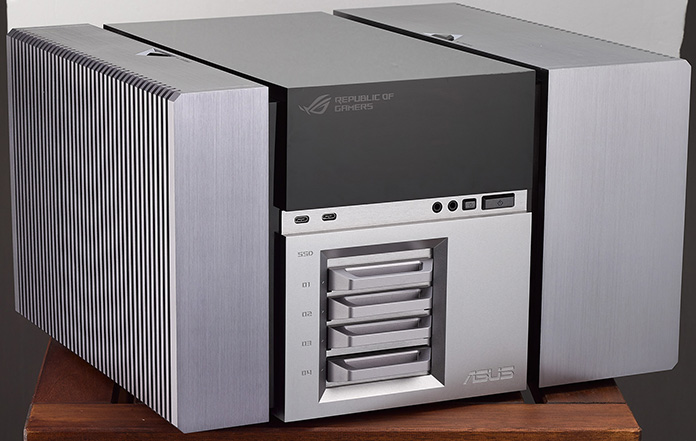
Thanks to standardised components and simplified operating systems (RIP MS-DOS), building a PC isn't all that difficult these days—so long as you're comfortable with wielding a Phillips head screwdriver, at least. Asus, however, thinks that it "can do it better."
Enter the Asus ROG (Republic of Gamers) Avalon concept PC, unveiled at Computex 2016 in Taiwan: a tightly integrated system that combines the motherboard and case into one, allowing for a modular and easily upgradable system that's (mostly) devoid of complex cabling.
Plus, it looks like a hi-fi straight out of a 1970's Technics catalogue—and as we all know, retro hi-fi is so in right now.
A modular system isn't an entirely new idea—see Razer's madcap Project Christine—although Asus is bullish about its product actually making it to market. "Unlike the purely aspirational concepts often seen in the tech industry, this prototype is a working system built on existing technologies that are viable to put into mass production," says Asus. Take that, Razer.
Avalon is essentially a hybrid motherboard and chassis that's built as a single unit, with PCIe-based "Edge Connector" slots for adaptor boards that allow for various upgrades. On the rear, for example, there's a slot for a modular I/O panel, each with differing ports depending on what you want to do. A Virtual Reality module includes extra USB ports, while a Home Theatre module contains an upgraded audio solution. There's also a Workstation module with two Ethernet sockets.
Up front there are slots for hot-swappable SSDs and traditional hard drives, all of which are connected up via a daughter card that talks to the motherboard. Even the PSU has been given the edge connector treatment, with Asus creating a custom unit that slides into place, delivering power to components directly via the motherboard, removing the need to deal with a tangled mess of cables.
-
The Avalon will feature interchangeable I/O modules that feature different ports for different use cases.
-
-
-
-
-
-
-
-
-
-
-
Despite Asus' efforts, it hasn't managed to completely remove all the cables and fiddly bits of building a computer. The CPU and RAM are still installed in the standard way—although presumably Asus could offer systems with these components pre-installed—while the graphics card still needs to be inserted into the PCIe slot on the outer edge of system, and power cables hooked up. An integrated backplate with threaded holes does take some of the sting out of installing a CPU cooler, but again, it's still something of a fiddly process.
Still, the Avalon is Asus' first pass at the idea, and it remains in the prototype stage, even if the company says it could start firing out units right now. There's price, no release date, and no plans for sampling just yet. Instead, Asus wants to know what the community and its partners think.
The Avalon is an interesting idea, but you have to wonder if enthusiasts—and let's face it, even with a slightly easier build process, it'll be advanced users who pick up an unit—will want to give up the freedom of the traditional build and be tied into Asus' hardware. That's not to mention that with motherboard and case being so tightly integrated, moving from one CPU generation to another will likely mean having buy a whole new Avalon system.
reader comments
124